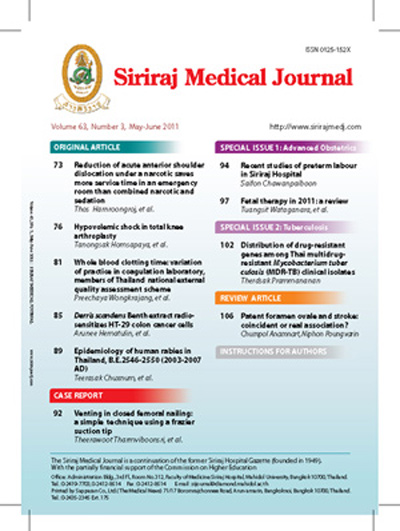Reduction of Acute Anterior Shoulder Dislocation under a Narcotic Saves More Service Time in an Emergency Room than Combined Narcotic and Sedation
Keywords:
Acute anterior shoulder dislocation; narcotic; sedation; post-reduction service time; emergency roomAbstract
Objective: To compare the post-reduction service time between using a narcotic and combination of a narcotic with sedative drugs for reduction of acute anterior shoulder dislocation.
Methods: Between 2004-2010, medical records and radiographs of patients who sustained acute anterior shoulder dislocation and obtained the successful reduction under sedation were reviewed. The patients were divided into 2 groups. Group 1, reduction was done under either intravenous morphine or pethidine and group 2, under either intravenous morphine or pethidine combined with diazepam. Post-reduction service times were recorded. The statistically significant difference was considered at p ≤ 0.05.
Results: 42 patients were divided to 2 groups (21 patients in each group). The mean post-reduction service time of group 1 was 62.10 (SD = 31.42) and group 2 was 87.57 (SD = 32.07) minutes. The statistical analysis showed that group 1 significantly spent 25.47 minutes less post-reduction service time than group 2 (p = 0.013).
Conclusion: Reduction of acute anterior shoulder dislocation under a narcotic significantly uses shorter post-reduction service time than under a combination of a narcotic with sedative drug in the emergency room.
References
2. Harnroongroj T, Rugpolmuang P, Keatkor S. A simple procedure for reducing anterior shoulder dislocation without anesthesia: Traction, abduction
and external rotation. Siriraj Hosp Gaz. 1999 Mar;51(3):153-7.
3. Anderson D, Zvirbulis R, Ciullo J. Scapular manipulation for reduction of anterior shoulder dislocation. Clin Orthop Relat Res. 1982 Apr;164:181-3.
4. Janecki CJ, Shahcheragh GH. The forward elevation maneuver for reduction of anterior dislocations of the shoulder. Clin Orthop Relat Res. 1982
Apr;164:177-80.
5. Lippert FG 3rd. A modification of the gravity method of reducing anterior shoulder dislocations. Clin Orthop Relat Res. 1982 May;165:259-60.
6. Poulsen SR. Reduction of acute shoulder dislocations using the Eskimo technique: a study of 23 consecutive cases. J Trauma. 1988 Sep;28(9):1382-3.
7. Russell JA, Holmes EM 3rd, Keller DJ, Vargas JH 3rd. Reduction of acute anterior shoulder dislocations using the Milch technique: a study
of ski injuries. J Trauma. 1981 Sep;21(9):802-4.
8. Cunningham N. A new drug free technique for reducing anterior shoulder dislocations. Emerg Med (Fremantle). 2003 Oct-Dec;15(5-6):521-4.
9. Kosnik J, Shamsa F, Raphael E, Huang R, Malachias Z, Georgiadis GM. Anesthetic methods for reduction of acute shoulder dislocations: a prospective
randomized study comparing intraarticular lidocaine with intravenous analgesia and sedation. Am J Emerg Med. 1999 Oct;17(6):566-70.
10. Moharari RS, Khademhosseini P, Espandar R, Soleymani HA, Talebian MT, Khashayar P, et al. Intra-articular lidocaine versus intravenous meperidine/
diazepam in anterior shoulder dislocation: a randomised clinical trial. Emerg Med J. 2008 May;25(5):262-4.
11. Miller SL, Cleeman E, Auerbach J, Flatow EL. Comparison of intra-articular lidocaine and intravenous sedation for reduction of shoulder dislocations:
a randomized, prospective study. J Bone Joint Surg Am. 2002 Dec;84-A(12):2135-9.
12. Dunn MJ, Mitchell R, Souza CD, Drummond G. Evaluation of propofol and remifentanil for intravenous sedation for reducing shoulder dislocations
in the emergency department. Emerg Med J. 2006 Jan;23(1):57-8.
13. Dunn MJ, Mitchell R, Desouza CI, Drummond GB, Waite A. Recovery from sedation with remifentanil and propofol, compared with morphine
and midazolam, for reduction in anterior shoulder dislocation. Emerg Med J. 2011 Jan;28(1):6-10.
Downloads
Published
How to Cite
Issue
Section
License
Authors who publish with this journal agree to the following conditions:
Copyright Transfer
In submitting a manuscript, the authors acknowledge that the work will become the copyrighted property of Siriraj Medical Journal upon publication.
License
Articles are licensed under a Creative Commons Attribution-NonCommercial-NoDerivatives 4.0 International License (CC BY-NC-ND 4.0). This license allows for the sharing of the work for non-commercial purposes with proper attribution to the authors and the journal. However, it does not permit modifications or the creation of derivative works.
Sharing and Access
Authors are encouraged to share their article on their personal or institutional websites and through other non-commercial platforms. Doing so can increase readership and citations.











